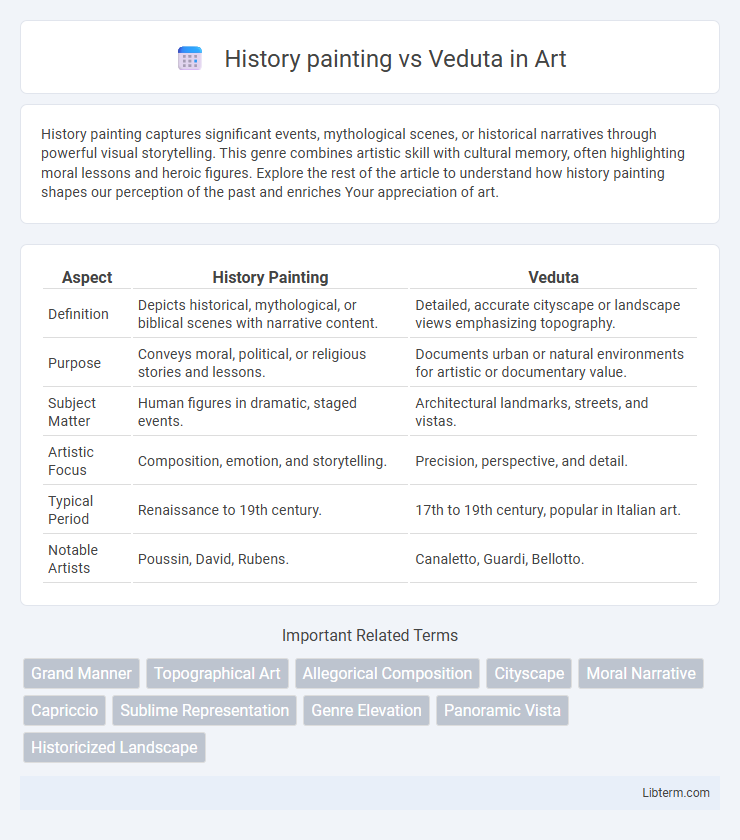History painting captures significant events, mythological scenes, or historical narratives through powerful visual storytelling. This genre combines artistic skill with cultural memory, often highlighting moral lessons and heroic figures. Explore the rest of the article to understand how history painting shapes our perception of the past and enriches Your appreciation of art.
Table of Comparison
| Aspect | History Painting | Veduta |
|---|---|---|
| Definition | Depicts historical, mythological, or biblical scenes with narrative content. | Detailed, accurate cityscape or landscape views emphasizing topography. |
| Purpose | Conveys moral, political, or religious stories and lessons. | Documents urban or natural environments for artistic or documentary value. |
| Subject Matter | Human figures in dramatic, staged events. | Architectural landmarks, streets, and vistas. |
| Artistic Focus | Composition, emotion, and storytelling. | Precision, perspective, and detail. |
| Typical Period | Renaissance to 19th century. | 17th to 19th century, popular in Italian art. |
| Notable Artists | Poussin, David, Rubens. | Canaletto, Guardi, Bellotto. |
Defining History Painting and Veduta
History painting is a genre that depicts scenes from classical history, mythology, religion, or allegory, often emphasizing narrative and moral themes with dramatic compositions. Veduta refers to highly detailed, large-scale paintings or prints of cityscapes or vistas, focusing on accurate representation and architectural precision. While history painting seeks to convey symbolic meaning and storytelling, veduta prioritizes topographical accuracy and visual documentation of real places.
Origins and Early Development
History painting originated in the Renaissance as a prestigious genre depicting religious, mythological, and historical narratives, emphasizing human figures and moral lessons. Veduta emerged in the 17th century, particularly in Italy, as detailed, large-scale cityscape paintings highlighting architecture and topographical accuracy for both documentary and tourist purposes. The early development of history painting centered on conveying dramatic storytelling through symbolic composition, while veduta prioritized realistic representation and geographic precision.
Key Characteristics and Artistic Styles
History painting features grand narratives drawn from historical, religious, or mythological events, emphasizing dramatic composition, expressive figures, and rich symbolism to convey moral or intellectual messages. Veduta, an Italian term meaning "view," specializes in meticulously detailed, realistic cityscapes or landscapes that capture architectural accuracy and atmospheric perspective, often serving as visual records of specific locales. While history painting prioritizes human action and allegory with dynamic movement and emotional intensity, veduta centers on precise spatial representation and visual clarity, reflecting Enlightenment-era interests in observation and empirical detail.
Prominent Artists and Iconic Works
History painting, characterized by grand narrative scenes from mythology, religion, and history, features prominent artists like Jacques-Louis David, whose "The Death of Socrates" exemplifies neoclassical precision. Veduta, a detailed cityscape or landscape genre, showcases artists such as Canaletto, renowned for his meticulously rendered views of Venice like "The Grand Canal from Palazzo Flangini to Campo San Marcuola." Both genres highlight artistic mastery: history painting with dramatic storytelling and veduta with architectural accuracy and vibrant urban scenes.
Subject Matter: Narrative vs. Landscape
History painting centers on grand narratives often drawn from mythology, religion, or historical events, emphasizing human figures and dramatic action to convey moral or heroic messages. Veduta artworks prioritize detailed, accurate landscape views of cities, natural scenes, or architectural landmarks, capturing spatial perspective without focusing on storytelling. The narrative-driven subject matter of history painting contrasts with the descriptive, panoramic emphasis found in veduta art.
Techniques and Materials Used
History paintings often employ oil on canvas, utilizing layered glazing techniques to create depth, dramatic lighting, and intricate detail that emphasize narrative and emotion. Veduta artists typically use precise linear perspective, watercolor, or gouache on paper, focusing on architectural accuracy and fine detail to represent cityscapes or landscapes realistically. The materials in history paintings favor richness and texture for storytelling, while vedutas prioritize clarity and precision through sharp lines and controlled brushwork.
Social and Cultural Significance
History painting, a dominant genre in European art from the Renaissance to the 19th century, portrayed grand narratives, mythological themes, and moral lessons, reflecting societal values and educating the public on cultural ideals. Veduta, detailed cityscape paintings originating in 17th-century Italy, documented urban environments with precise accuracy, serving as visual records of social progress and prestige for both local communities and travelers. Both genres shaped cultural identity: history paintings reinforced collective memory and ethical codes, while vedute celebrated architectural achievements and the evolving social landscape.
Evolution Through Art Movements
History painting, characterized by its narrative scenes from mythology, religion, and historical events, evolved through art movements such as Neoclassicism and Romanticism, emphasizing drama and moral messages. Veduta, a detailed and accurate representation of cityscapes and landscapes, gained prominence during the Baroque and Enlightenment periods, reflecting a shift toward realism and topographical precision. Both genres illustrate the changing cultural and artistic priorities, with history painting focusing on allegory and ideology, while vedute highlight empirical observation and urban expansion.
Influence on Contemporary Art
History painting, characterized by grand narratives and mythological or historical subjects, has deeply influenced contemporary art through its emphasis on storytelling, dramatic composition, and moral themes. Veduta, a detailed and precise representation of cityscapes or landscapes, has contributed to contemporary art by inspiring realism, spatial accuracy, and the appreciation of urban and natural environments. The contrasting approaches of History painting's narrative depth and Veduta's meticulous observation continue to inform modern artistic practices and visual culture.
Legacy and Continued Relevance
History painting remains a cornerstone of Western art, revered for its grand narratives and moral lessons that continue to influence contemporary storytelling in visual media. Veduta, with its precise and detailed cityscapes, offers invaluable historical records and insights into urban development, appealing to collectors and historians alike. Both genres sustain their relevance through continued exhibitions, scholarly research, and adaptation in modern artistic practices, preserving their legacies as vital cultural documents.
History painting Infographic

 libterm.com
libterm.com